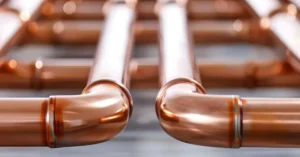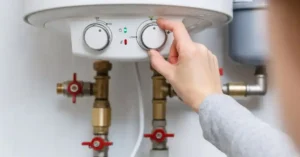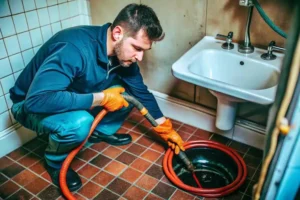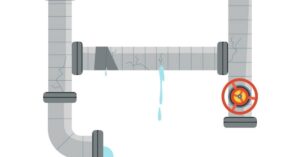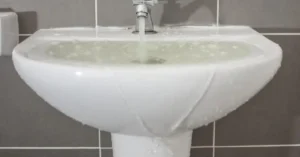A clogged bathroom sink is a common problem that brings daily life to a grinding halt. If water won’t drain, your simple morning routine turns into a big mess. The good news? You can fix most clogs yourself without a pricey emergency call.
This in-depth guide will show you exactly how to unclog your bathroom sink using simple tools and household items, saving you time and money today. We’ll cover everything from simple boiling water fixes to using a drain snake, making sure you can get your water flowing freely again.
Why Your Bathroom Sink is Not Draining

Your bathroom sink stopped up for specific reasons. Hair is the main culprit. It wraps around the drain stopper and catches soap residue, creating a thick mat that blocks water flow.
Soap scum builds up on pipe walls over time. It narrows the passage and slows drainage. Toothpaste, shaving cream, and skincare products add to this sticky mess.
The P-trap under your sink collects debris. This curved pipe holds water to block sewer gases. But it also catches objects that slip down the drain. Jewelry, cotton swabs, and dental floss often lodge here.
Hard water leaves mineral deposits in pipes. These crusty layers reduce pipe diameter and make clogs worse. If you live in an area with hard water, this buildup happens faster.
Sometimes the vent stack gets blocked. Your plumbing needs air to drain properly. A clogged vent creates slow drainage throughout your bathroom.
Unclog a Sink Drain With Boiling Water
This method works best for fresh clogs caused by soap and grease buildup. Start by removing standing water from your sink using a cup or bowl.
Boil a full kettle of water. You need at least six cups for this to work. Pour the boiling water directly down the drain in three stages. Wait 10 seconds between each pour.
The hot water melts soap scum and grease. It pushes the softened blockage through your pipes. This method costs nothing and takes five minutes.
Test your drain by running cold water. If it drains slowly, repeat the process. For tough clogs, move to the next method.
Important note: Don’t use boiling water if you have PVC pipes. Temperatures above 175°F can soften and damage PVC. Use hot tap water instead.
Unclog a Sink With Vinegar and Baking Soda
This natural solution breaks down organic matter without harsh chemicals. The fizzing reaction helps dislodge hair and soap buildup.
Remove the drain stopper first. Most pop-up stoppers twist counterclockwise to come out. Clean off any visible hair and gunk.
Pour one cup of baking soda down the drain. Use a funnel if you have one. Follow with one cup of white vinegar. Cover the drain with a wet cloth or plug to contain the reaction.
Wait 30 minutes while the mixture works. You’ll hear fizzing as the vinegar and baking soda react. This creates carbon dioxide that pushes against the clog.
Flush with hot water for five minutes. The clog should wash away. This method is safe for all pipe types and won’t damage your plumbing.
Repeat if your bathroom sink is clogged but draining slowly. Some tough clogs need two or three treatments.
Unclog a Sink with a Plunger
A plunger creates pressure that forces clogs through pipes. You need a cup plunger, not a flange plunger. The cup type has a flat bottom and works better on sinks.
Fill your sink with enough water to cover the plunger cup. This creates a seal for better suction. Remove the overflow cover if your sink has one. Cover the overflow hole with a wet rag or duct tape.
Place the plunger over the drain opening. Press down firmly to create a seal. Push down and pull up rapidly 15 to 20 times. Don’t break the seal during plunging.
Remove the plunger and check if water drains. If the bathroom sink clogged condition continues, repeat the process three or four times.
The vacuum action pulls debris loose from pipe walls. The pressure pushes it through your plumbing system. This method works on most hair and soap clogs.
Unclog a Sink With a Drain Snake
A drain snake reaches clogs that other methods can’t touch. You can buy a basic snake for $10 at any hardware store. Professional plumbers use motorized versions, but manual snakes work fine for home use.
Remove the P-trap under your sink first. Place a bucket underneath to catch water. Loosen the slip nuts with pliers or by hand. Pull the P-trap down and empty it.
Check the P-trap for clogs. Clean it with a brush and hot water. If the clog isn’t here, it’s deeper in the drain pipe.
Insert the snake into the drain pipe opening. Feed it slowly while turning the handle clockwise. You’ll feel resistance when you hit the clog.
Push and pull the snake while turning. This breaks up the blockage. Hair wraps around the snake’s tip or auger. Pull out the snake and clean off debris.
Run hot water through the drain for several minutes. Reattach your P-trap and test the sink. This method clears unclogging bathroom sink problems that happen deep in pipes.
Unclog a Sink With a Wet-Dry Vac
A shop vacuum pulls clogs out instead of pushing them through. This method works when you can’t reach the blockage with a snake.
You need a wet-dry vacuum for this technique. Regular vacuums aren’t built for water and will break.
Set your vacuum to wet mode. Remove the filter if your model requires it. Check your manual for proper setup.
Create a tight seal around the drain. Press the vacuum hose firmly against the drain opening. You can wrap a wet towel around the hose for a better seal.
Turn on the vacuum at full power. The suction pulls water and the clog toward the vacuum. Hold the seal for 30 to 60 seconds.
Check if the toilet sink clogged issue is resolved. This powerful method often succeeds where plungers fail. The strong suction dislodges stubborn blockages.
Empty your vacuum immediately after use. Clean the hose to prevent mold growth. This technique is especially good for solid objects stuck in drains.
What NOT to Use: Chemical Drain Cleaners
Store-bought drain cleaners seem convenient, but they cause more harm than good. These products contain harsh chemicals like sulfuric acid or sodium hydroxide.
Chemical cleaners generate heat that can crack porcelain and damage pipes. They’re especially dangerous for older plumbing systems. PVC pipes can soften and warp from the heat.
These products rarely fix the problem completely. They might clear surface blockages but leave residue that attracts more buildup. Your clog returns within weeks.
Chemical cleaners create toxic fumes that irritate your eyes, nose, and lungs. They’re dangerous if splashed on skin. Mixing different drain cleaners can produce deadly gases.
They harm the environment when they enter water systems. The chemicals don’t break down easily and pollute waterways.
Professional plumbers struggle to work on pipes after chemical cleaner use. The residue makes their job harder and more dangerous.
Save your money and your pipes. Use the natural methods described above instead.
Tips for Keeping Your Bathroom Sink Clear
Prevention saves you from future clogs and repair costs. Here are practical ways to keep your drain flowing freely.
Install a drain catch or hair strainer. These mesh screens cost a few dollars and catch hair before it enters your pipes. Clean the strainer weekly.
Run hot water after each sink use. This flushes soap and toothpaste residue through your pipes before it hardens. Just 30 seconds of hot water makes a big difference.
Clean your pop-up stopper every two weeks. Hair wraps around this component quickly. Unscrew it, remove trapped hair, and rinse thoroughly.
Use the vinegar and baking soda treatment monthly. This preventive maintenance dissolves buildup before it becomes a problem. Think of it as a pipe cleaning routine.
Brush your hair before showering or washing. This removes loose hair that would otherwise go down your drain. Less hair means fewer clogs.
Don’t pour grease or oil down your sink. These substances solidify in pipes and create sticky traps for other debris. Wipe greasy containers with paper towels first.
Use a water softener if you have hard water. This reduces mineral buildup in your pipes. Your drains will flow better for years.
Schedule annual drain inspections. A professional can spot problems before they become emergencies. This proactive approach saves money long-term.
You can read about: Why Does My Bathroom Smell Like Sewage?
When To Call a Professional Plumber
Some situations require expert help. You’ve tried every method and your bathroom sink is still clogged. The water won’t budge, or it drains extremely slowly despite your efforts.
Multiple drains in your home are backing up. This points to a main line problem, not just a bathroom sink issue. Tree roots or major blockages need professional equipment.
You smell sewage coming from your drain. This indicates a serious plumbing problem that affects your health. Don’t wait to address this issue.
Water backs up into other fixtures when you run the sink. This suggests a blocked vent pipe or main drain line. These problems need specialized tools to fix.
You see water damage under your sink. Leaking pipes can cause mold growth and structural damage. A plumber can identify the source and make proper repairs.
Your drain makes gurgling sounds constantly. This usually means air is trapped in your plumbing system. The vent stack might be blocked or improperly installed.
If you need help with toilet installation in Eagle Rock or complex plumbing work, Derks Plumbing provides expert solutions for all your bathroom plumbing needs.Our licensed plumbers are equipped with the training, experience, and tools to handle everything from stubborn clogs to severe pipe damage.
Older homes often have corroded pipes that need replacement. A plumber can assess your entire system and recommend solutions. Sometimes fixing the immediate clog isn’t enough if your pipes are deteriorating.
Professional drain camera inspections reveal hidden problems. Plumbers insert tiny cameras into pipes to see exactly where and what is causing blockages. This technology saves time and prevents unnecessary pipe damage.
Conclusion
Dealing with a clog sink in bathroom is a frustration everyone faces, but you are now equipped with the knowledge to handle it. By starting with simple methods like hot water or the natural fizz of vinegar and baking soda, you can fix most slow drains quickly. Moving to a plunger or a drain snake offers mechanical solutions for tougher clogs. Remember, avoid chemical drain cleaners at all costs to protect your home’s plumbing system.
By applying these methods, you can successfully learn How To Unclog Your Bathroom Sink and keep your plumbing healthy for years to come.
FAQs
How do I unclog a bathroom sink without a plunger or snake?
You can start by using the boiling water method to dissolve soap and grease. If that fails, try the vinegar and baking soda remedy, which uses a natural foaming action to loosen the clog. For a quick manual fix, you can use a bent wire coat hanger to fish out the hair and debris near the top of the drain.
Is it safe to use baking soda and vinegar on all pipes?
Yes. Baking soda and vinegar are non-corrosive and generally safe for all types of plumbing, including metal and plastic (PVC) pipes. They are a much safer alternative to harsh chemical cleaners when your unclogging bathroom sink is needed.
Why is my bathroom sink stopped up right after I cleaned it?
If your bathroom sink stopped up again immediately, it likely means you only punched a small hole through a large, solid blockage (like a big hairball) instead of removing the entire mass. You need to use a drain snake to physically pull the entire clog out.
What is the purpose of the overflow hole in the bathroom sink?
The overflow hole prevents the sink from flooding your bathroom if you forget to turn off the water while the drain is stopped up. When you use a plunger or wet-dry vac, you must block this hole so the pressure or suction works only on the clog.
Does a toilet sink clogged mean the toilet is also clogged?
Not usually. The toilet and sink drains join the main waste pipe further down the line. However, if both your toilet and sink are backing up, it’s a strong sign that the main drain pipe for your home is blocked, and you should call a plumber.


